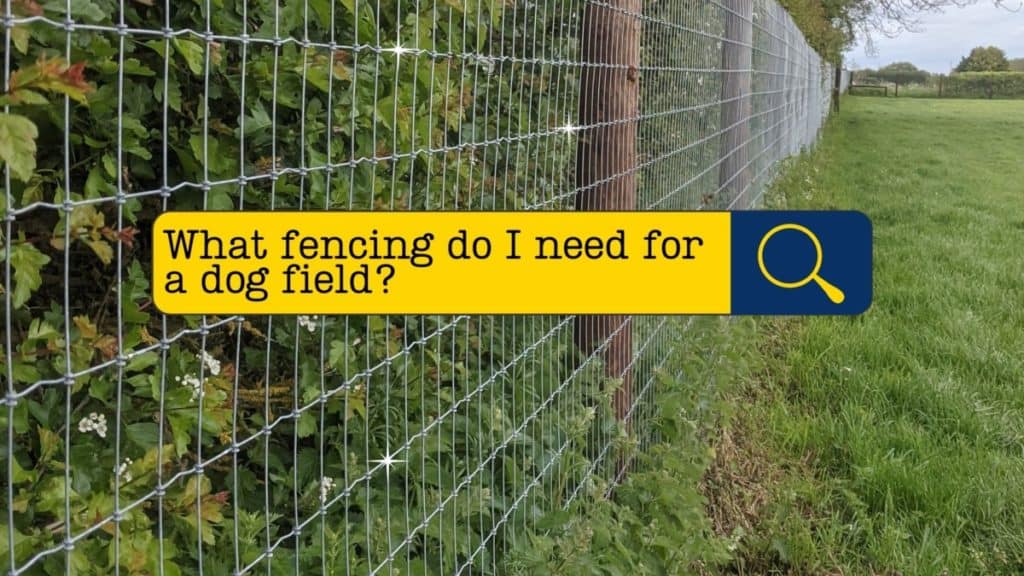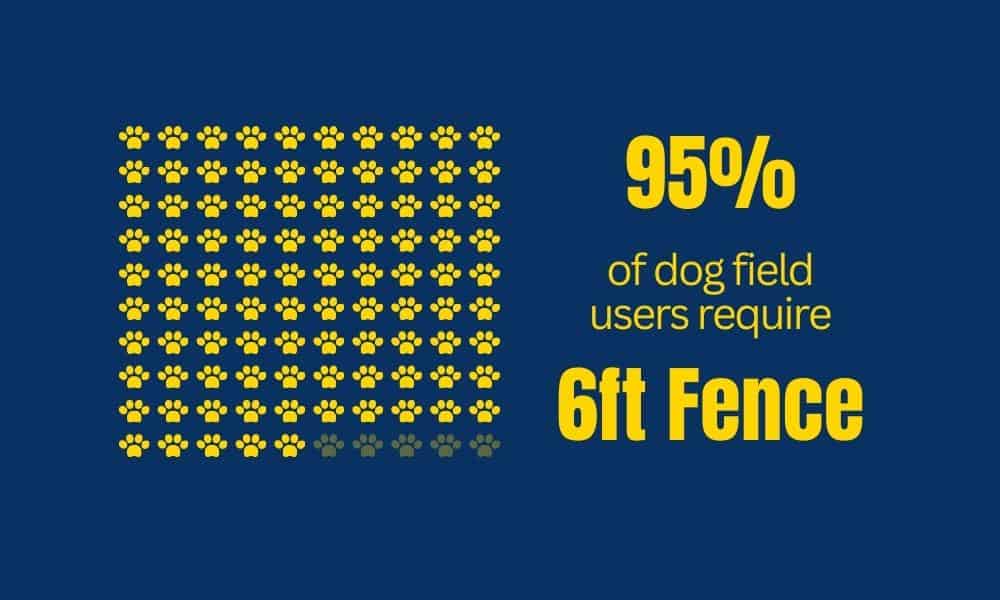Setting up a dog field is a costly exercise whether you already have land or not – there are significant costs associated with gaining planning permission, excavation for parking areas and business administration including public liability insurance and running a booking system.
However, by far your biggest expenditure after the land costs will be your fence. Getting this right so that you maximise your revenue and minimise your ongoing maintenance costs is something you need to focus on from day one of planning.
Traditionally, there are three main fence heights on offer at most dog fields:
4ft (1.2m) – often standard stock fencing with a top line to extend the height
5ft (1.5m) – Less common due to its lack of demand in the wider fencing market
6ft (1.8m) – Most common with most variation in design
There are lots of reasons why you might choose a 4ft or 5ft fence over 6ft fence so we conducted some research with our audience to find out exactly what it is they expect from a dog field fence:
Results from a poll* by British Dog Fields across social media showed that over 95% of regular dog field users who participated require their dog fields to have a minimum fence height of 6ft.
(*Poll results last updated in 2023)
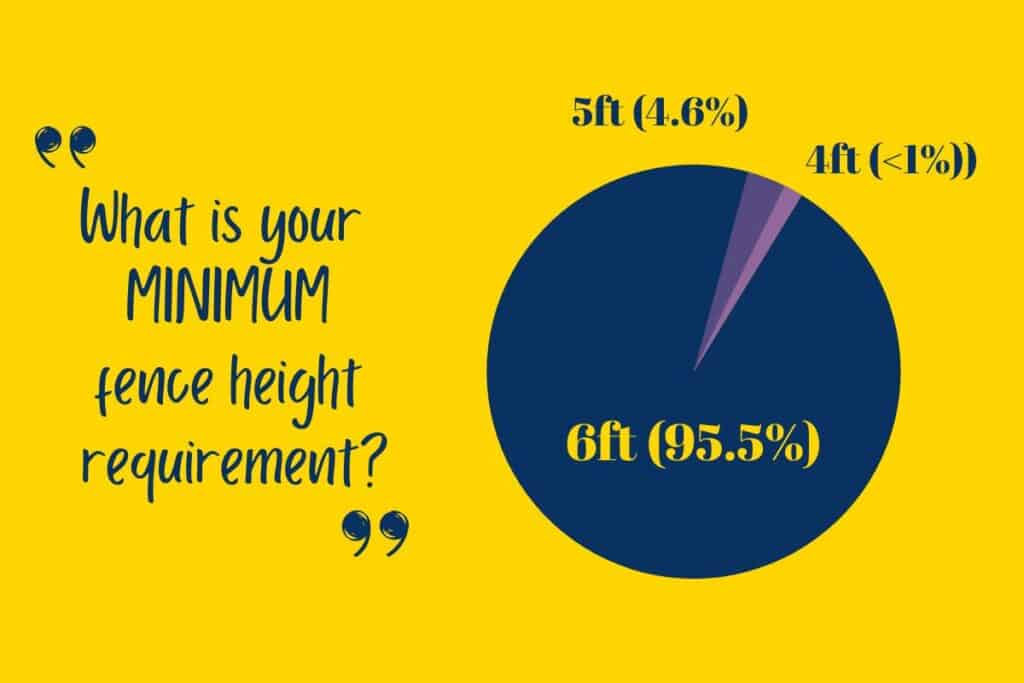
This result is not unexpected. 6ft fences offer a belt and braces facility for most dog field users which is what many of us are searching for!
It’s true to say that the majority of domestic dogs in the UK would find a well-installed 5ft fence a significant challenge to scale however, 6ft fences are what we as users of dog fields have come to expect from a secure dog field. If you’re completely new to the concept of secure dog fields I have written an article on Secure vs Enclosed fields here which explains the main differences between the two in terms of definition.
In this article, we’ll go through a few of the things that might influence the height of fencing you choose so you can start the planning process.
There is no doubt that if you want to maximise your income and make your business robust in the face of increasing local competition, you need to install fences with a minimum height of 6ft or 1.8m (give or take a cm or two). However, there are many things to consider.
Cost of Fencing
The price of setting up a dog field has nearly doubled in the last 3 years (2023). Raw materials like timber and surface coverings like limestone have gone through the roof. Installing good quality fences and creating a parking area are not ‘nice to have’ elements of a dog field – they are essential so there’s no way around this expenditure.
What we are seeing in an attempt to reduce the set-up costs of a dog field is the installation of 5ft fences. The reality is that there aren’t that many dogs capable of scaling a 5ft fence that can’t scale a 6ft fence with equal grace (yes Malinois owners, we’re looking at you!).
The truth is for many owners like me, the psychological impact of a 6ft fence is that I can’t see over it. I can easily see over a 5ft fence and for that reason, despite knowing full well that I have never seen either of my dogs attempt a 4ft fence let alone a 5ft fence, I choose fields with 6ft fences.
Here’s how the cost impacts your fencing choice:
4ft fences can be installed relatively easily by inexperienced people with inexpensive equipment. Therefore, as well as the fencing material costs being significantly lower, so are labour charges, even if you employ a contractor.
Whilst we do not recommend it, 5ft fences can be installed by a practical person with kit that you can rent or find someone locally who’ll help you out for a few days.
The weight of the netting is the killer so renting equipment that can hold and roll-out these hefty reels is the key to success. Getting the tension can be more challenging but this is just about doable as a DIY job if you know what you’re doing and are very physically capable. The downside of 5ft fencing is that the cost saving over a 6ft fence is more marginal than you might expect. 5ft fencing has not been a high-demand product until more recently but more options are becoming available.

6ft fences are a different kettle of fish and are no place for amateurs! Having reviewed well over 200 dog field fences in person, I think I could take my place on a fencing contractor’s quiz team. I can tell if a fence has been installed by a good professional contractor who knows what they’re doing, or someone who has bitten off far more than they can chew.
Everything is harder to install, it takes longer and it costs more.
Planning Conditions
“But I don’t need planning to put up a 6ft fence!”
A. Landowner
No you don’t, but you do need planning permission for a change of use which is why a planning officer can influence the type of fencing you install. Don’t shoot the messenger!
You may be required to install shorter or taller fencing than you wished to – planning officers across the UK and Ireland have become more familiar with the concept of dog fields and what their overall impact can be – as well as having significantly more cases to reference than a few years ago.
Here are a few reasons why you might have some fence height conditions imposed on your dog field:
- Your field is in an AONB where there is a policy to reduce the visual impact of fencing in the countryside
- You’ve insisted on a very imposing style of fencing that is very out of place in the environment
- The quantity of fencing you are installing is visually impactful
- The planning officer has no experience of dog fields, reactive dogs, what’s required or what is safest so makes their own personal judgement in line with their interpretation of the planning policy
It’s not as common as it once was to have a debate with the planning authorities about fence height for dog fields and it is something you should address in your planning support documents.
If you do have any challenges you’d like to overcome regarding anything above, please drop me an email – alongside our planning partners we have overcome a number of these pitfalls, made and won approval for larger fences.
‘Run What You Brung’
Unless you have well-installed and maintained fences of 4ft or higher, ‘testing the market’ by opening a field surrounded by old stock fencing (even with top wires) is a recipe for disaster.
You are not testing the market, you are playing an elimination game with your prospective customers – people with any experience at all of dog fields will not feel safe, and won’t come back (that’s if they even get out of the car). Even once you have replaced your fence with something more suitable, you will struggle to gain back their trust – do not underestimate how seriously dog owners take the safety and security of their pets – this would be a perilous mistake.
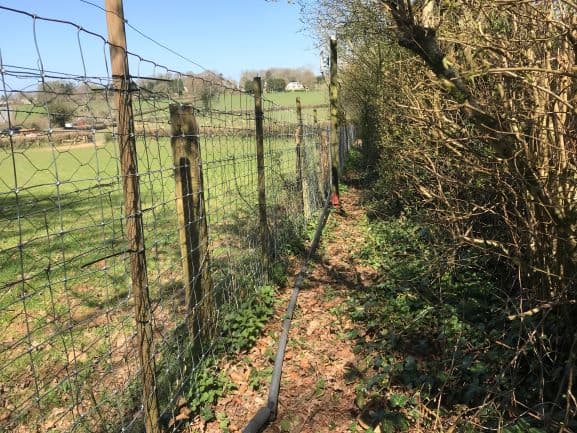
It’s Not What You’ve Got, But What You Do With It
If you’re restricted by budget or planning conditions, or indeed it’s just your personal preference, opening a field with a 4ft or 5ft fence does not need to be commercially impracticable – but you do have to market yourself correctly and make sure that the fence you do have is suitable.
If you are installing a 5ft fence or lower, the smart decision is to use equestrian specification fencing (or similar) which has small holes between the wires (if using net fencing) – this means that whilst your field might not appeal to the mid and larger sized athletic dogs, you can make a good business specialising in smaller dogs and puppies – as long as the aperture of your fencing is small enough to prevent even the smallest teacup yorkie making a break for it!
There are some really effective ways to appeal to a slightly different market if you have a field with 5ft fencing or lower that will set you apart from those fields with 6ft fencing.
No Doubt – 6ft Fencing Is The Best Option
There’s very little jeopardy in opening a dog field – they can be very successful when designed and run properly, regardless of location and size. However, the fencing height and type you choose does have an impact on potential revenue and long-term success which is supported by our recent poll.
If you’re in the process of planning your field and are struggling to decide what type and style of fencing to use?; what materials are best?; what the low maintenance options are?; what is safest?; and what is the most economical solution?, drop us an email or book into a ‘Start up Consultation’ via our online booking system where we can offer personalised advice specific to your circumstances.
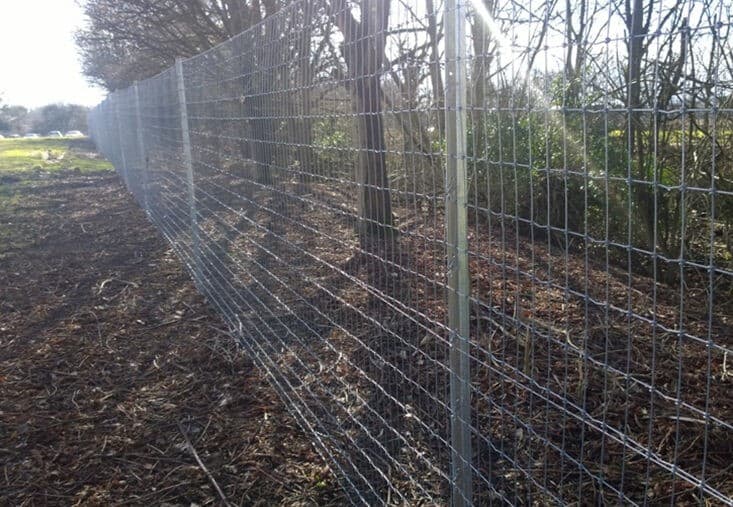
If you want to know more about what kind of fencing you should choose, check out this article:
